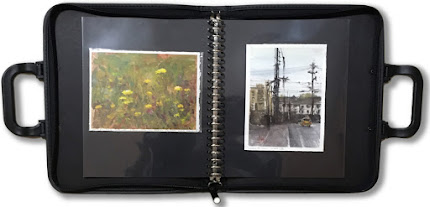If you have not read “It's as Easy as A, B, and C" please click HERE and do that exercise first as it lays important groundwork for this one.
Drawing is not so much about the eye or the hand per se. It is more about how your mind processes and understands what is being observed through the lens of the eyes giving your hand the ability to draw a subject more accurately. This exercise is going to “force” your mind to process what it is looking at which will enable you to draw with more accuracy.
Art Materials:
Three pieces of paper and pen or marker (no pencil), a 500 ml/16 oz) water bottle, some form of timer (watch, phone, cooking timer, etc.)
Set-Up:
Place the water bottle* about two feet (60 cm) away from you and your drawing materials. Please note that the distance here is important. You will be doing three timed drawings of 5 minutes each. Using a timer helps you to focus on the drawing and not the time.
* If you prefer a more challenging object, feel free to select something else. However, keep it in the same general size as the water bottle.
Exercises:
1. Start your timer, set for 5 minutes. On the first piece of paper, draw the water bottle, ignore any text, logos, etc. Just focus on the shapes and relationships of the bottle. Do not worry about being perfect. When the timer goes off, stop drawing, even if you have not completely finished. Write the letter "A” somewhere on the page.
2. Look at this first drawing comparing it to the bottle. Note any elements that are out of proportion or out of relationship. For example, the cap is too big or too small, the bottle is too wide or too thin, etc. Keeping this information in mind, turn drawing "A" face down until the end of the exercise.
3. Reset Your timer. Draw the water bottle a second time and label it drawing “B”. Repeat the assessment process you did in step 2 with drawing "B". Turn it face down.
4. Draw the water bottle for the third time as before. Label this "C”. Review it as above.
5. Now turn over all three drawings. You should see a progressive improvement from “A” to "B" to “C”. Not just in terms of accuracy, but also in terms of feeling more confident with each successive drawing. The lines in your final drawing might seem more assertive, less hesitant. The last drawing of the three is usually the best.
What Happened?
You did not suddenly acquire “talent” over the 15-minute span you were sketching in. As you drew, then redrew, the bottle, your mind became more and more familiar with the subject. The bottle’s height to width ratio, the cap's size compared to the rest of the bottle, where the neck of the bottle turned out, etc. The shapes and relationships began to be more consciously understood, or "seen" in your mind.
Visual Memory Files
Accurate drawing is about understanding as much information regarding your subject as you can before putting a mark down on your paper. It is building what I call a Visual Memory File. The more information you learn about your subject, the more data you put into your Visual Memory File, the more accurate your drawing will be. We will look at ways to plan and develop Visual Memory Files in upcoming posts.
Drawing is about understanding
as much information regarding your
subject as you can before putting
a mark down on your paper.
One Strike and You're Out?
Ironically, many people will try drawing something once, but seeing that it doesn’t look right, they give up. If they had continued doing another drawing or two they would have seen much improvement. Without realizing it, their mind had started the process of building a Visual Memory File.
Only for Beginners?
Many professional artists and illustrators have learned the benefit of drawing or painting their subjects numerous times. They practice this with both old and new subject matter. It is invaluable in the planning and preparation for a final drawing or painting.
Now that you have worked through this exercise, repeat it using other objects always trying to work from life as much as you can.






















